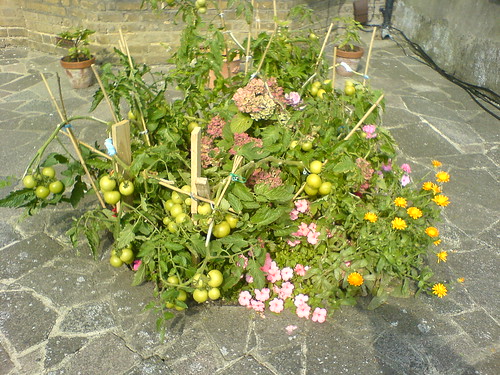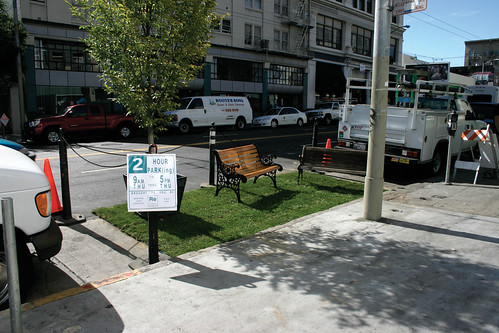The primary physical manifestations of these trends include a turn away from luxury retailers to discount superstores, the emergence of the ridiculous "recessionista" trend, and a significant decrease in vacation plans. More interestingly, some cultural pastimes recently relegated to nostalgia are once again becoming popular. One blog lists 67 Cheap Date Ideas for the Recession-Era Romantic. The general flavor of the cultural swing can be drawn from the following suggestions:
Browse the local farmers’ market.
Go on a picnic.
Go apple picking.
Attend an open-air festival.
Attend an art gallery.
Pick up a movie at your local library.
Go window-shopping.
Watch Shakespeare in the Park.
Skip rocks at a lake.
Take dance lessons at a local community center.
Consider what kind of reaction might have been expected to the activities on the above list as few as three years ago. What is striking about these activities is not their affordability, but the extent to which they utilize public space and amenities as the setting for recreation and socialization. It seems that the economic recession has singlehandedly revived the recently moribund concept of public space. In locations where parks, plazas, and playgrounds already exist creative programming can help to attract residents and provide a civic amenity.
Unfortunately in the current situation the funding streams for many of these programs are drying up and beleaguered city and state governments typically do not prioritize civic amenities. However, maintaining such programming to support a civic life has positive tertiary effects on everything from crime to property values. As Noah Kazis argues:
These events are not about “quality of life” in terms of concrete provision of goods or services. These kinds of events are valuable only because they are about building local community, real or imagined. In some places, these events are at the local enough level that you see the neighbors you know and the ones that you should get to know in a friendly environment.
...
Building these communities is important. Community cohesion is important for keeping down crime, for fostering local businesses, for all sorts of things. Intuitively, I think everyone knows that when you walk into a vibrant community, as opposed to just a neighborhood, you know instantly it’s a place you want to be.
The development of a vibrant and civic minded neighborhood is the definition of sustainability. Many important figures have noted that citizen participation is the bedrock of a sustainable pattern of urbanism. Once initially educated on core concepts of sustainability, residents are best equipped to devise and propose new initiatives, and it is this civic engagement that has contributed to the success of significant projects.
Clearly the cultivation of civic engagement and vibrant urban spaces is important. The irony of the current blossoming of interest in urban civic space is that the same economic conditions that instigated this cultural shift also curtail government spending. In the current economic climate quality of life projects unfortunately take a back seat to other more pressing concerns. This does not have to happen. Most civic projects focusing on public spaces concentrate on large visions of redevelopment.
Vibrancy can also be built from a number of inexpensive tactical incisions into the urban fabric. After all, small projects can turn urban space into an urbanism of the scavenger hunt to encourage walking, which in turn stimulates small businesses.
I have gathered five techniques to reinforce public space to inspire everyone to take up the cause of guerilla urbanism. These are presented in order of least to most expensive.
#1: Poster Pocket Gardens.
Artists Sean Martindale and Eric Cheung used the existing posters plastered on building sides and utility poles as a container for public greenery. This method has some promise for an urban-scaled plant sharing cooperative. Sprout extra seeds? Just leave them on the corner telephone pole!
 Poster pocket plants in Toronto (via Spacing Toronto).
Poster pocket plants in Toronto (via Spacing Toronto).#2: Crack Gardens.
Although this project by CMG Landscape Architecture was a formal garden design for a residential property, it points to a tactic to be used on crumbling streets and alleys of urban areas. Such gardens could also help to limit stormwater pulses by absorbing rainwater and limiting runoff.
 Crack Garden by CMG Landscape Architecture (via Pruned).
Crack Garden by CMG Landscape Architecture (via Pruned).#3: Garden Sharing.
OregonLive reports on Alice Lasher and Sue Decker who have begun sharing gardens and trading produce for labor. Their garden extends over property lines and along parking strips by the street. Expanding personal gardens to the neigborhood scale produces community interaction and results in a concrete benefit: good produce from underutilized land.
 TH - Best Front Garden Produce by szcze.
TH - Best Front Garden Produce by szcze.#4: Temporary PARK(ing).
The Rebar art collective in San Francisco deployed the initial PARK(ing) intervention on November 16, 2005 from noon until 2 p.m. Visitors enjoyed the turf and took turns paying the meter. Since then the phenomena has taken off into a network and numerous deployments have taken place across the United States. While the construction of this type of intervention is moderately expensive, the iconic image and ease of transport make it a great anti-car advocacy tool.
 PARK(ing) Project 2005 iteration (via Rebar).
PARK(ing) Project 2005 iteration (via Rebar).#5: Dumpster Diving.
Reminiscent of a cross between Ken Smith's Dumpster Gardens and the old Situationist slogan "Beneath every paving stone, a beach!", this project by MACROSEA in Brooklyn only took 12 days to build. Like the PARK(ing) project, this concept could be a significant tool to revitalize places with a dearth of public amenities. Furthermore, this project suggests ways to deploy significant civic infrastructure using readily available materials on a small budget.
 Dumpsters turned beaches (via ReadyMade).
Dumpsters turned beaches (via ReadyMade).







0 reactions:
Post a Comment